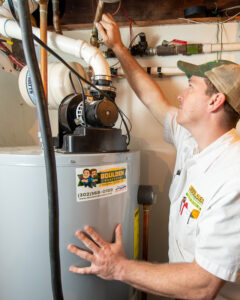The Technology Behind 
Solar water heaters have become a popular choice for households and businesses as a sustainable and cost-effective way to heat water. But how exactly do these systems work?
In this article, we will delve into the technology behind solar water heaters and discuss their components, pros and cons, and overall benefits to the environment and our wallets.
So let’s dive in and explore the inner workings of a solar water heater. Let’s start with what exactly a solar water heater is and how it functions.
What is a Solar Water Heater?
A solar water heater is an innovative device that harnesses energy from the sun to heat water for various purposes. This technology operates on the principles of thermodynamics and heat transfer, using the sun’s energy to heat water for everyday use. But how exactly does it work? Let’s find out.
The Technology Behind Solar Water Heaters
As mentioned earlier, solar water heaters consist of several components that work together to heat and store water. The main component is the solar collector, which absorbs solar radiation and converts it into heat energy. This heat energy is then transferred to the storage tank, where it can be used for later use.
There are two types of solar collectors – flat plate and evacuated tube. Flat plate collectors are more commonly used and consist of a flat panel with tubes or channels running through it to circulate the water. Evacuated tube collectors, on the other hand, have glass
The Technology Behind Solar Water Heaters
Solar water heaters are not a new technology, but they have become increasingly popular in recent years. This is due to advancements in technology and incentives from governments and utilities to encourage the use of renewable energy sources.
As mentioned earlier, solar water heaters work on the principles of thermodynamics and heat transfer.
When sunlight hits the collector, it is absorbed by a dark-colored plate and converted into heat energy. This heat is then transferred to the water in the collector’s pipes, which circulates through the system using a pump. The storage tank is also an essential part of the technology behind solar water heaters. It not only stores the heated water but also acts as insulation to prevent heat loss.
The type of storage tank used can affect the overall efficiency of the system, making it an important consideration when choosing a solar water heater. In addition to the components mentioned, some systems may also have backup heat sources or electric heating elements to ensure hot water is always available. This can be useful in areas with less sunlight or during times of high demand.
Solar Collector
The solar collector is a crucial component of a solar water heater as it is responsible for absorbing solar radiation and converting it into heat energy. This process is known as the greenhouse effect, where the collector acts similarly to a greenhouse by trapping solar radiation and converting it into heat.
There are two main types of collectors used in solar water heaters – flat plate and evacuated tube. Flat plate collectors consist of a flat, rectangular panel with tubes running through it, while evacuated tube collectors have rows of tubes that are aligned parallel to each other.
Flat plate collectors are more affordable and easier to install compared to evacuated tube collectors. However, evacuated tube collectors have higher efficiency due to their design, which allows for better insulation and reduced heat loss.
The proper placement and orientation of the collector are crucial for maximizing its efficiency. A south-facing roof with a slope between 20-50 degrees is ideal for most locations in the Northern Hemisphere. However, for optimal efficiency, the collector’s angle should be adjusted according to the latitude of the location.
Storage Tank
The storage tank is an essential component of a solar water heater. It stores hot water produced by the collector until it is needed for various purposes. The size of the storage tank will depend on the household’s hot water usage and the size of the collector.
There are two main types of storage tanks used in solar water heaters – single-tank systems and two-tank systems.
The single tank system is a more straightforward and compact option, where the storage tank is integrated into the collector. This design allows for easier installation and maintenance but may result in heat loss during cold weather.
On the other hand, a two-tank system separates the storage tank from the collector. This setup allows for better temperature control and can be more efficient in colder climates. However, it may require more space for installation and is typically more expensive.
Circulation Pump
The circulation pump is responsible for moving water from the solar collector to the storage tank. It ensures continuous heat transfer, as warm water flows into the tank and cooler water is pumped back to be heated by the collector again. This process continues until the desired water temperature is reached.
In some systems, there may be a secondary circulation pump in addition to the primary one. This secondary pump can serve as a backup in case the primary pump fails or can provide additional heat transfer for larger storage tanks. It also allows for more flexibility in system design and operation.
It is crucial to properly size and install the circulation pump to ensure efficient and effective operation of the solar water heater. A professional installer can assist in selecting the right pump for your specific system.
Controls
The control system of a solar water heater is responsible for regulating its operation and ensuring maximum efficiency. It works by controlling various components of the system, such as the circulation pump and temperature sensors.
Automatic controls use sensors to monitor the temperature of the water in the collector and storage tank. When the temperature reaches a certain level, the control system activates the circulation pump to transfer hot water from the collector to the storage tank. Once the desired temperature is reached, the pump is turned off. This process repeats throughout the day as long as sunlight is available.
Conclusion
In conclusion, solar water heaters are an innovative and eco-friendly technology that harnesses the sun’s energy to heat water. They operate on the principles of thermodynamics and heat transfer, using components such as collectors, storage tanks, circulation pumps, and controls.
While there are different types of solar water heaters with their advantages and disadvantages, they all contribute to reducing energy costs and promoting sustainability.
